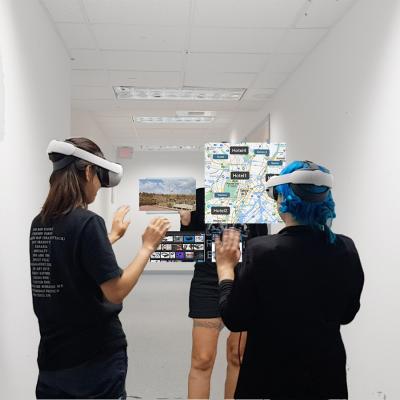Related People
David Lindlbauer
Carnegie Mellon University's XRTC Will Drive Research into VR, AR Innovations

Virtual, augmented and other extended reality technologies present the possibility to transform health care, education, entertainment, communication and more.
And that transformation is close.
Headsets and haptic gloves could connect doctors and patients thousands of miles apart in a virtual hospital. Sensors could monitor someone's health or help teachers know if their students are paying attention. Scanners could allow objects from a person's home to appear in their favorite video game. Glasses could help people with visual impairments navigate the world around them. Extended reality (XR) technologies have the potential to complement or replace smartphones, laptops, tablets and other devices for many tasks.
Carnegie Mellon University has launched its Extended Reality Technology Center (XRTC) to bring together researchers, industry and consumers to maximize the potential of emerging developments in the field. The XRTC will drive the development of extended reality technologies, create a curriculum to train the next generation of XR talent, and encourage consumers to participate in its design and ultimately use the new tools.
"XR technologies will allow us to mix the digital world and the real world in ways that will improve how we work, play, learn, connect, and care for ourselves and others," said Fernando De La Torre, a co-director of the XRTC and an associate research professor in the Robotics Institute. "This is happening now. The technology is not yet mature, but the breakthrough is going to happen in the next five to 10 years, and CMU will be there when it happens."
Extended reality technologies are a natural next step in the evolution of computing. From large mainframes that took up entire rooms through the advent of desktop computers to the internet and smartphones, computing has become more personal, more connected and a larger part of people's lives. XR technologies take it a step further.
The XRTC will be led by co-directors De La Torre, Kris Kitani and David Lindlbauer, all faculty in the School of Computer Science (SCS). The center will unite researchers from across the university including from elsewhere in SCS and in the College of Engineering, Heinz College of Information Systems and Public Policy, College of Fine Arts, Dietrich College of Humanities and Social Sciences, CMU Libraries, and Entertainment Technology Center. The XRTC's work will be based at the new Robotics Innovation Center at Hazelwood Green.
"CMU has dozens of faculty and hundreds of students pushing boundaries in all the areas needed for extended reality technologies to be successful. It's unlikely another university in the United States or in the world has this many people working on this technology," said Lindlbauer, an assistant professor in the Human-Computer Interaction Institute. "We have the expertise. We just needed to bring this expertise together, and the XRTC does that."
The XRTC will launch with founding sponsors PNC and Fujitsu, companies that see XR technologies as transformative to their businesses and customer interactions.
PNC is a longtime partner of CMU. It previously invested in the PNC Center for Financial Services Innovation to capitalize on new technologies and the effectiveness of data to advance the functionality of banks and the services they offer customers. Its investment in the new XRTC is the latest demonstration of its commitment to enhancing innovative educational resources at CMU.
"Virtual reality has so many potential applications and is such an exciting space for those of us at PNC interested in the 'art of the possible,'" said Michael Degnan, head of enterprise innovation at PNC. "As part of our ongoing efforts to work collaboratively with CMU to advance our headquarters city of Pittsburgh as a center of technological innovation, we see this investment in the XRTC as the establishment of a new, regional space for discovery that will help many."
Fujitsu and CMU have collaborated on projects to use social digital twin technology to help create safer, more sustainable cities in the future and achieve breakthroughs in dynamic 3D structure representation that could be used for better simulation analysis and avatars. The Japanese company aims to use XR technologies to enhance working across physical and digital environments.
"Fujitsu has been thinking about how to utilize digital space for people to work more effectively. While keeping up overall productivity, the individual's engagement level should be taken care of as well in the digital workplace. We're excited about joining the XRTC community to explore technologies and partnerships toward this vision," said Naoki Matsuoka, a project director in Fujitsu Research's Converging Technologies Laboratory.
CMU is world-renowned for its innovations in the technologies driving the development of XR — mobile computing, chipsets, wireless broadband, computer vision, machine learning and user interfaces. The XRTC will focus its work in three areas: research to tackle emerging topics in XR; education to develop a new curriculum at the undergraduate, graduate and executive levels; and community to bring new technology to the public's attention, allowing for participation in its design and encouraging adoption.
The center will host an annual symposium to share the latest research and development in XR from academia and industry, and organize demo days, museum exhibitions and outreach workshops. It held its first XRTC Symposium on Nov. 9 at CMU, where researchers showcased the latest in XR technologies and led a wide-ranging discussion about the future of VR, augmented reality and other related fields.
"The XRTC Symposium was a great opportunity to see the kind of XR work already happening at CMU and to demonstrate that work to potential sponsors and future collaborators," said Kitani, an associate research professor in the Robotics Institute. "We've only recently launched and the excitement is already building."
Learn more about the XRTC, including how to become a sponsor, on the center's website.
For More Information
Aaron Aupperlee | 412-268-9068 | aaupperlee@cmu.edu
Research Areas

